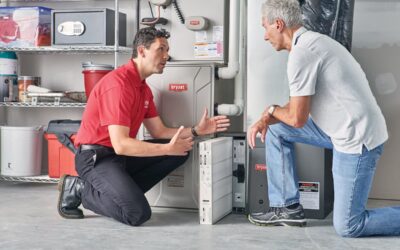Indoor heating is something that many people take for granted. When the mercury drops, you want a furnace that’s capable of keeping you and your family warm. Not all heaters are made equal, however, which is why it’s important to choose the right type.
1) Single-Stage vs. Two-Stage Furnace
When shopping for a new furnace, you’ll need to choose between a single-stage or two-stage unit. A single-stage furnace puts out the same temperature heat every time it runs, whereas a two-stage furnace has two temperature settings for its heat output.
Single-stage furnaces operate at full capacity, regardless of the surrounding climate and the homeowner’s heating needs. A two-stage furnace, on the other hand, runs at low capacity by default. If the low setting isn’t providing enough heat to meet the homeowner’s demands, it will kick over to the high-capacity setting.
While single-stage furnaces are cheaper than two-stage heaters, the latter is more efficient, making them a better deal in the long run. According to Angie’s List, single-stage furnaces have an annual fuel utilization efficiency (AFUE) of approximately 80 percent. In comparison, two-stage furnaces have an AFUE of 98.5 percent. The higher the AFUE, the less energy the furnaces uses to achieve its target temperature.
2) Fixed Speed vs. Variable Speed
Something else to consider is whether the furnace has a fixed-speed or variable-speed blower (also known as multi-speed). Both types use a motorized fan to blow heated air through the ducts. A fixed-speed blower distributes heated air at a single speed; with a variable-speed blower, the rate varies.
Like a two-stage furnace, a variable-speed blower will first attempt to use the lowest speed to reach the target temperature. If it’s unable to achieve the temperature set by the homeowner, the fan will increase its speed. Some of the benefits of choosing a furnace with a variable-speed blower include:
- More energy efficient than conventional fixed speed.
- Improves air quality by continually blowing air through the filter.
- Produces less noise when operating at lower speed settings.
Keep in mind that a two-stage furnace can also feature a variable-speed blower and that “speed” only refers to the blower, not the actual furnace.
3) Fuel Type
Furnaces run on gas, oil or electricity. While all three types are fully capable of heating the average home, you shouldn’t overlook the nuances between them.
Here’s a brief overview of the three different fuels used in furnaces:
- Gas — The most popular type, natural gas furnaces are cheap and easy to operate. With natural gas supplied through underground utility lines, you don’t have to worry about it refilling it. However, installing a gas furnace in a home that doesn’t already have a gas line can be expensive.
- Oil — An alternative to natural gas is an oil- or propane-powered furnace. They are durable, efficient, and generate the most heat of all three furnace types. Oil is stored locally, however, so homeowners must refill their furnace’s tank regularly to keep it operational.
- Electric — These furnaces run off local power, eliminating the need for a separate gas bill. Electric furnaces heat up more slowly than gas- and oil-powered ones, which may deter some homeowners from choosing them.
Consider whether your home currently has a gas line. If it does, perhaps a gas-powered furnace is the right choice. If it doesn’t, you may want to stick with an oil or electric-powered model instead.
4) Furnace Size
Contrary to popular belief, a bigger furnace isn’t always better. An oversized furnace will frequently cycle on and off, consuming more power while also wearing down its mechanical components and shortening its lifespan.
But you should also avoid buying a furnace that’s too small for your home. If it’s not big enough, it won’t have the power to keep your home warm during those chilly winter days.
The size and power of a furnace are measured in British Thermal Units (BTUs). A single BTU is the thermal heat needed to raise the temperature of 1 pound of water by 1 degree Fahrenheit. BTUs are used to measure the thermal output of many heating and cooling devices, including furnaces.
To determine what BTU size furnace you need, hire a professional HVAC technician to perform a load calculation using the “Manual J” method. That involves calculating various factors such as square footage, insulation value, insulation placement, exposures, etc. Choosing a furnace sized appropriately for your home can prevent headaches later down the road.
5) Fuel Efficiency Rating
Check the annual fuel utilization efficiency (AFUE) rating when choosing a furnace. That is a measurement of how efficiently the furnace converts fuel to heat over a one-year period. A 90 AFUE electric furnace, for instance, produces 90 BTUs of heat for every 100 BTUs of electricity, with the remaining 10 percent wasted in the exhaust. Ideally, you choose a furnace with the highest possible AFUE for its respective fuel type.
It’s important to note that federal laws require all home furnaces in the northern region to have an efficiency rating of 90 AFUE or higher, and 80 AFUE or higher for homes in the southern region.
6) Tax Credits
The federal government, to encourage energy efficiency in the home, offers tax credits on certain types of furnaces. As explained on the official ENERGY STAR website, this includes a $150 credit for eligible furnaces and a $50 credit for a main circulating fan.
For homeowners to receive this credit, the furnace must be powered by gas, feature the ENERGY STAR logo, and have a 95 or higher AFUE rating. Homeowners in the Southern states are not eligible to receive this tax credit. If your furnace meets this criterion, you can apply for the tax credit on the ENERGY STAR website.
Following the tips listed here should help you choose the right furnace for your home. Just remember to consider the number of stages it has, blower speed, fuel type, size, efficiency rating, and whether it’s eligible for tax credits.


